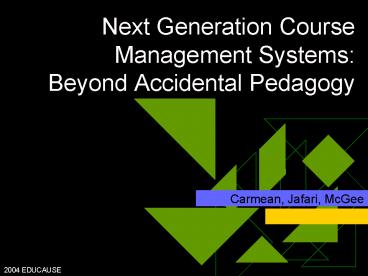Next Generation Course Management Systems: Beyond Accidental Pedagogy - PowerPoint PPT Presentation
1 / 28
Title:
Next Generation Course Management Systems: Beyond Accidental Pedagogy
Description:
History, Practices and Design. From fringe application to enterprise system ... Evolution of TV Remote Control. First Generation. Advanced model. Preferred ... – PowerPoint PPT presentation
Number of Views:100
Avg rating:3.0/5.0
Title: Next Generation Course Management Systems: Beyond Accidental Pedagogy
1
Next Generation Course Management Systems
Beyond Accidental Pedagogy
- Carmean, Jafari, McGee
2
How we got here
- Learner-centered Principles
- NLII Research Key Theme
- NLII Focus Session
- Work Group
3
CMS for Learning Beyond Accidental Pedagogy
- History, Practices, and Uses of Current CMS
- Research Implications and Creative Innovations
- A Next Generation Learning System
4
History, Practices and Design
- From fringe application to enterprise system
- From instructor-driven to strategic investment
- From out-of-the-box to semesters of experience
and intentional use - From IT as provider to IT as academic support
Colleen Carmean
5
NG AssessmentNo more evasion
- Our haste from hence is of so quick
conditionThat it prefers itself and leaves
unquestion'dMatters of needful value. - Duke Vicentio (Act 1), Measure for Measure
Colleen Carmean
6
Assessment Stakeholders
- Instructors
- Learners
- Support staff
- Leadership
- Libraries
Colleen Carmean
7
NG Standards Specifications
- Interoperability, reusability, manageability,
accessibility - metadata, content, databases repositories
- designs for learning, vocabularies, learner
profiles assessment - expression of competencies
- networking protocols
Colleen Carmean
8
NG Tearing down the container
- Cross-course resources
- Public vs private space
- Library access and resources
- Discipline-based resources
Colleen Carmean
9
Learning, Learning,Learning
- Mapping the Learning Space
- http//www.educause.edu/AMapoftheLearningSpace/261
9
Colleen Carmean
10
Next Generation Learning
- Active
- Social
- Contextual
- Encourages Engagement
- Requires Ownership
Colleen Carmean
11
Learning design
- User-centered
- Access controls
- Utilize authentic learning
- Social
- Collaborative
- Support higher order and deeper thinking
- Collect
- Explore
- Document
- Scaffold
- Problem Solve
Patricia McGee
12
Learning and teaching
- Generative
- Learning objects
- Demonstrative
- Summative assessment
- Support smart pedagogy
- Distributed and interactive content
- Learner capacity building
- Teach to Learn
Patricia McGee
13
Managing knowledge
- Support knowledge organization
- Cognitive Supports
- Organizational Tools
- Connective Functions
- Reflective
- ePortfolios
- Formative assessment
Patricia McGee
14
Designing the Next Generation Teaching Learning
Environment
- Major Tasks
- Understanding the current systems
- Understanding the current users needs
- Speculating future users needs
- Proposing new conceptual and technical
environments for teaching and learning
Ali Jafari
15
A Next Generation Learning EnvironmentFunctional
Specifications
- Comprehensive tool box
- Smart system
- Dynamic interface
Ali Jafari
16
A Next Generation Learning EnvironmentFunctional
Specifications
- Comprehensive tool box
- Beyond Course Management Systems
Ali Jafari
17
A Next Generation Learning EnvironmentFunctional
Specifications
Smart system Ability to think, reason, and
react
Ali Jafari
18
A Next Generation Learning EnvironmentFunctional
Specifications
Dynamic interface Personalized navigation
scheme based on a users preferences
Ali Jafari
19
Evolution of TV Remote Control
First Generation
Preferred Model
Advanced model
Ali Jafari
20
Evolution of TV Remote Control
First Generation
Preferred Model
Advanced model
CMS Today
Ali Jafari
21
What is Next?
- To conduct a systematic research on understanding
the current systems and inquiring about future
needs. - Jafari Sabbatical research project, spring 2005.
Ali Jafari
22
CMS Communities
23
CMS Communities
5
1
2
3
8
6
4
9
7
24
Research Methodology
- Multiple case study through which a cross-case
analysis process will be used to investigate a
series of questions as they relate to design,
use, and support of CMS in academia. - Sponsored by select CMS vendors, developers, and
HE institutions.
Ali Jafari
25
Tentative Research Questions
- Research questions
- What are the limitations of current learning
systems and software solutions from the
perspective of end users? - What are the technological support issues of
learning systems from the perspectives of IT
administration and support personnel? - What is the vision of the software developer for
creation of the next generation of teaching and
learning environment? - What are the needs and/or expectations of the end
users, IT administration, and software developers
for the next generation of the teaching and
learning environment? - To what extent do the current standards and
interoperability activities support future needs? - What technical and conceptual issues are causing
current campus portals projects to fail? - How should ePortfolio services be integrated with
current and future learning environments? - What are the functional requirements of an
intelligent learning environment from the
perspective of end users? - What are the technical requirements for an
intelligent learning environment from the
perspective of developers? - How can the current navigational scheme and user
interface design of current course management
systems be improved? - What are the potential viable system design
options for the next generation of the teaching
and learning environment? - What is the extent to which commonly-used
productivity software tools (i.e., Microsoft
Office Suite) should be integrated into the next
generation of the teaching and learning
environment? - What communication channels (i.e., hand-held
devices, cell phone, the like) other than a
computer screen could be useful in the next
generation of the teaching and learning
environment? - What are the human-factor issues within the
current system which must be addressed in the
next generation of the teaching and learning
environment?
Ali Jafari
26
Call for Collaboration
- Contact Jafari_at_iupui.edu or visit
www.ePortConsortium.org
27
contacts
- Colleen Carmean - carmean_at_asu.edu
- Ali Jafari - Jafari_at_iupui.edu
- Patricia McGee - pmcgee_at_utsa.edu
- http//faculty.coehd.utsa.edu/pmcgee/ngcms.htm
28
contacts
- Colleen Carmean - carmean_at_asu.edu
- Ali Jafari - Jafari_at_iupui.edu
- Patricia McGee - pmcgee_at_utsa.edu
- http//faculty.coehd.utsa.edu/pmcgee/ngcms.htm































